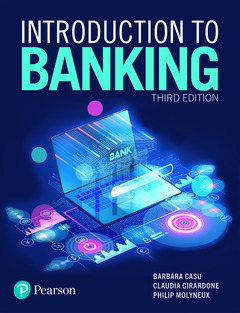Description
Introduction to Banking (3rd Ed.)
Authors: Casu Barbara, Girardone Claudia, Molyneux Philip
Language: English
Subjects for Introduction to Banking:
75.10 €
In Print (Delivery period: 14 days).
Add to cart
Publication date: 11-2021
840 p. · 19x24.7 cm · Paperback
840 p. · 19x24.7 cm · Paperback
Description
/li>Contents
/li>Biography
/li>Comment
/li>
Gain a thorough insight into the business of banking
Introduction to Banking, 3rd edition, by Casu, Girardone and Molyneux offers an in-depth overview of the theoretical and applied issues in the global banking industry. Organised into five sections, it covers contemporary topics in banking, ranging from central banking and bank regulation, to bank management and corporate governance, providing the most up-to-date information on banking practice.
The new edition discusses the developments contributing to the rapid transformation of the banking sector, such as digitalisation of banking and emergence of non-bank providers, the growing importance of sustainable banking, the FinTech boom, the impact of Covid-19 on banking services, structural and regulatory changes in the banking industry, and the growth of Islamic banking.
Suitable for all undergraduate students taking a course in banking as well as professionals entering this industry, this text also provides background reading for postgraduate students on more advanced topics in banking.
?I truly welcome this thoroughly revised edition of the Introduction to Banking textbook. Its authors are world-class scholars who on a daily basis research a wide array of highly relevant banking topics and maintain many close contacts with the commercial and central banking community. I can see no better guides to lead undergraduates into the fascinating (and at times bewildering) banking landscape.?
- Steven Ongena, Professor of Banking, University of Zurich, Swiss Finance Institute and CEPR
About the authors:
Barbara Casu is the Director of the Centre for Banking Research at Bayes Business School, City, University of London where she is Professor of Banking and Finance.
Claudia Girardone is Professor of Banking and Finance, Director of Essex Finance Centre (EFiC) and the Essex Business School's Director of Research.
Philip Molyneux is Emeritus Professor at Bangor University.
Pearson, the world's?learning?company
Preface
Acknowledgements
List of abbreviations and acronyms
Part 1 Introduction to banking
1. What is special about banks?
2. Bank activities and services
3. Types of banking
4. International banking
5. Islamic banking
Part 2 Central banking and bank regulation
6. Central Banking
7. Bank regulation and supervision
8. Bank failures and banking crises
Part 3 Issues in bank management
9. Banks' balance sheet and income structure
10. Bank financial management
11. Banking risks
12. Bank risk management
Part 4 Comparative banking markets
13. Banking in the UK
14. Banking in Europe
15. Banking in the US
16. Banking in Japan
17. Banking in emerging markets
Part 5 Advanced topics in banking
18. Banks and markets
19. Mergers and acquisitions
20. Bank competition and financial stability
Appendix A1 Interest rates, bonds and yields
Appendix A2 Introduction to portfolio theory
Glossary
References and further reading
Index
Barbara Casu is the Director of the Centre for Banking Research at Bayes Business School, City, University of London where she is Professor of Banking and Finance. She is also the Director of the Bayes Executive PhD Programme. She has over 50 publications in peer-reviewed journals, including Review of Economics and Statistics, Journal of Money, Credit and Banking and Journal of Corporate Finance.
Claudia Girardone is Professor of Banking and Finance, Director of Essex Finance Centre (EFiC) and the Essex Business School's Director of Research. She has published over 50 articles in peer-reviewed international journals, including Journal of Corporate Finance, European Journal of Operational Research, Journal of Financial Stability and Journal of Financial Services Research.
Philip Molyneux is Emeritus Professor at Bangor University. He previously was the Dean of the College of Business Administration at the University of Sharjah. He has published widely in the banking area including articles in the Journal of Money Credit and Banking, Journal of Banking and Finance, Journal of Financial Intermediation, Review of Finance and Journal of Financial Stability.
Real-life understanding of concepts and key developments
- Comprehensive insight into banking sector: The text covers theoretical and applied issues relating to the global banking industry, highlighted by examples from across Europe and the wider international arena.
- Focus on bank management: With a strong focus on bank management issues, the title prepares students to understand the different financial features of commercial and investment banking business.
- Advanced topics in banking: From the growth of the ‘shadow banking system' to bank mergers and acquisition activities, and issues and challenges surrounding the industrial structure of modern banking markets, the text focuses on the key issues in banking industry.
Focus on applied learning
- Theory into practice: The title includes Financial Times articles with news from the banking/financial industry. This allows students to connect theory with the real world.
- Evaluation of practical problems: End-of-chapter questions require students to solve practical problems and to reflect on some of the practical implications of important issues in banking.
- International focus: The text covers institutional features and structural trends of various banking systems, including the UK, Europe, US, Japan and other emerging banking markets.
User-friendly structure
- Consistent framework: The text is organised into five main sections offering 20 chapters, each chapter opening with an Introduction which summarises the aim of the chapter.
- Instructor's reso
© 2024 LAVOISIER S.A.S.
These books may interest you

Introduction to banking 70.66 €

The Oxford Handbook of Banking 152.43 €


